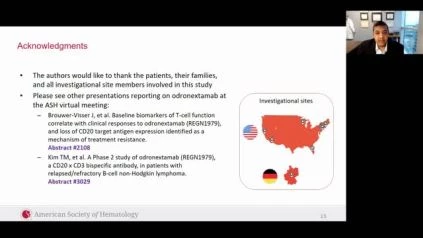Rajat Bannerji, MD, Ph.D. Chief, Section of Hematologic Malignancies at Robert Wood Johnson University Hospital and Rutgers Cancer Institute of New Jersey, an expert in hematology/oncology, lymphoma and clinical trials Rutgers Cancer Institute of New Jersey speaks about the ASH 2020 Abstract – 400 Odronextamab (REGN1979), a Human CD20 x CD3 Bispecific Antibody, Induces Durable, Complete Responses in Patients with Highly Refractory B-Cell Non-Hodgkin Lymphoma, Including Patients Refractory to CAR T Therapy.
REFERENCE:Â
In a first-in-human study of patients (pts) with relapsed/refractory (R/R) B-cell non-Hodgkin lymphoma, Odronextamab (REGN1979) is a first-in-class, hinge-stabilized, completely human IgG4-based CD3 x CD20 bispecific antibody (bsAb) that has shown promising safety, tolerability, and tentative efficacy (B-NHL). Updated safety and efficacy data from the dose-escalation and early dose-expansion process of the Phase (P)1 ongoing study are published (NCT02290951).
METHODS: Odronextamab was administered using a step-up dose schedule consisting of an initial weekly dose (W)1, an intermediate weekly dose (W2), and, subsequently, a fixed weekly dose (W12) accompanied by Q2W maintenance. To reduce the risk of cytokine release syndrome, dexamethasone premedication was used to (CRS). The key objectives were to test the safety and dose-limiting toxicity (DLTs) and to decide the maximum tolerated dose (MTD) and the prescribed dosing regimen for P2 (RP2DR). A tentative evaluation of anti-tumor activity was included in the secondary objectives.
RESULTATIONS:
127 pts with R/R B-NHL were treated at doses ranging from 0.03 to 320 mg as of Jun 25, 2020. Pts with diffuse large B-cell lymphoma (DLBCL; n=71), grade (Gr) 1-3a (n=37) follicular lymphoma (FL), mantle cell lymphoma (MCL; n=11), marginal zone lymphoma (n=6), and other B-NHLs (n=2) were included in the analysis. Pts were strongly refractory (80.3%) and received a median of 3 prior therapy lines (range: 1-11); 29 pts (22.8%) received prior CAR T therapy (FL: 2; DLBCL: 25; MCL: 2) and 85 pts (66.9%) in either therapy line were double refractory to alkylator and anti-CD20 antibodies. The median follow-up was 3.9 months (0.4 to 376) (mo).
During the dose-escalation, no DLTs were identified, and MTD was not achieved with doses of odronextamab up to 320 mg weekly.
Pyrexia (76.4 percent), CRS (62.2 percent), and chills were the most common treatment-related adverse effects (AEs) of any kind (48.0 percent ). 8 pts (6.3 percent) of Gr 3 CRS occurred and 1 pt of Gr 4 CRS occurred (0.8 percent ). In the first 2 weeks of step-up dosing, most of the CRS incidents occurred and were resolved with supportive treatment interventions within a median of 2 days (range 1-41). Odronextamab therapy due to CRS was not discontinued by pts. There were 5 pts of Gr 3 neurologic AEs, of which only 3 (2.3%) were deemed treatment-related: somnolence, syncope, and encephalopathy. None of those incidents involved the discontinuation of treatment. No Gr 4 or higher neurologic AEs were present. Overall, because of medication-related AEs, 7 pts (5.5 percent) discontinued treatment.
Odronextamab showed a wide therapeutic activity window in pts with R/R FL Gr 1–3a. Objective response rate (ORR) was 92.9 percent in pts treated at doses of ⇠5 mg (n=28), and complete response (CR) rate was 75.0 percent; median response period (DoR) was 7.7 mo (range 0+–20.9+), with 13 of 21 CRs ongoing at last tumor evaluation. The complete response median period (DoCR) was 8.1 mo (range 0+–19.9+) and follow-up is ongoing.
The encouraging activity was observed in pts with R/R DLBCL at higher dose levels of odronextamab. In DLBCL pts who had not undergone previous CAR T therapy, treated at doses of ⇠80 mg (n=10), the incidence of ORR and CR was 60%; the median DoR observed was 10.3 mo (range 2.9-18.6+), with 4 of 6 CRs ongoing at the last evaluation of the tumor. The DoCR median was 9.5 mo (range 2.9-18.6+) and there is ongoing follow-up. ORR was 33.3 percent in DLBCL pts that were refractory to previous CAR T therapy, treated at doses of ⇠80 mg (n=21), and CR rate was 23.8 percent; median DoR observed was 2.8 mo (range 0+-18.9+), with 5 of 5 CRs continuing at last tumor evaluation. The median DoCR was 4.4 mo (range 0+-18.9+) and there is continuing follow-up.
RP2DR for dose-expansion cohorts has been defined based on an assessment of preliminary antitumor activity and PK.
Observations:
Odronextamab has demonstrated promoting single-agent antitumor activity in extremely refractory pts with B-NHLs. In both indolent and violent B-NHL pts, durable CRs have been found, including in pts refractory to CAR T therapy. At the time of the data cutoff, most CRs are continuing, and updated data will be presented. Odronextamab has an appropriate profile for safety and tolerability. Premedication and step-up dosing with dexamethasone mitigate the risk of CRS and allow odronextamab to be given up to 320 mg weekly without DLTs. A global P2 trial is underway to examine odronextamab in R/R B-NHL.

